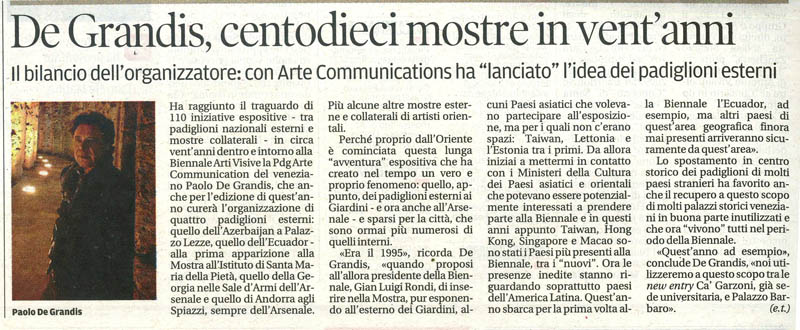
DE GRANDIS, 110 EXHIBITIONS IN TWENTY YEARS
Paolo De Grandis, creator of the Collateral Events
"The budget of the organizer: Arte Communications has "launched" the idea of outdoor pavilions."
La Nuova Venezia PDG Arte Communications
He reached the milestone of 110 exhibition initiatives - including national pavilions and collateral exhibitions - in about twenty years in and around the Visual Arts Bienniale with PDG Arte Communications from the Venetian Paolo De Grandis, that for this year's edition will cure the organization of four outdoor pavilions: the Azerbaijan Pavilion at Palazzo Lezze, the Ecuador Pavilion as first appearance in the event at the Institute Santa Maria della Pietà, the Georgian Pavilion in the Sale d’Armi - Arsenale and the Andorra Pavilion at Spiazzi, always in the Arsenale.
Plus some other collateral exhibitions of Asian artists, because from the East initiated this long "adventure" of exhibitions, which has created over time a real phenomenon: that, exactly, of the outdoor pavilions from the Giardini. and now Arsenale - and scattered around the city, which are now more numerous than those interiors.
<<It was 1995>>, remembers De Grandis, <<when "I suggested to Gian Luigi Rondi, then President of the Biennale, to insert in the Event, while exposing outside of the Gardens, some Asian countries who wanted to participate in the exhibition, but for which there were no spaces: Taiwan, Latvia and Estonia among the first. Since then I started to get in touch with the Ministries of Culture of Asian countries that could potentially be interested in taking part in the Biennale and during those years precisely Taiwan, Hong Kong, Singapore and Macao were the most presented countries at the Biennale, among the "new". Now unpublished attendance is covering mainly Latin American countries. This year arrives for the first time at the Biennale the Ecuador, for example, but other countries from this region which have never been present before will come in the future >>.
The shift in the historical center of the halls of many foreign countries has also aided the recovery in this very purpose of Venetian palaces largely unused and now with the opportunity to "live" during the period of the Biennale.
<<This year for example>>, concludes De Grandis, << we will use for this purpose between the newcomer Ca 'Garzoni, former university, and Palazzo Barbaro>>.
(Enrico Tantucci)